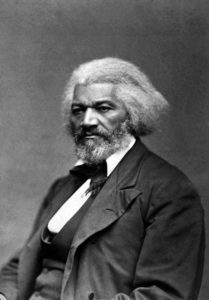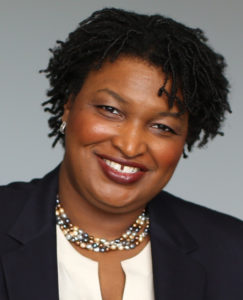Frederick Douglass

Frederick Douglass (born Frederick Augustus Washington Bailey; February 1818 died February 20, 1895) was an American social reformer, abolitionist, orator, writer, and statesman. After escaping from slavery in Maryland, he became a national leader of the abolitionist movement in Massachusetts and in New York, becoming famous for his oratory and incisive antislavery writings. Accordingly, he was described by abolitionists in his time as a living counter-example to slaveholders’ arguments that slaves lacked the intellectual capacity to function as independent American citizens. Likewise, Northerners at the time found it hard to believe that such a great orator had once been a slave.
Douglass wrote several autobiographies, notably describing his experiences as a slave in his Narrative of the Life of Frederick Douglass, an American Slave (1845), which became a bestseller, and was influential in promoting the cause of abolition, as was his second book, My Bondage and My Freedom (1855). Following the Civil War, Douglass remained an active campaigner against slavery and wrote his last autobiography, Life and Times of Frederick Douglass. First published in 1881 and revised in 1892, three years before his death, the book covers events both during and after the Civil War. Douglass also actively supported Women Suffrage and held several public offices. Without his approval, Douglass became the first African American nominate for Vice President of the United States as the and Vice-Presidential nominee of Victoria Woodhull, on the Equal Rights Party ticket.
Douglass was a firm believer in the equality of all peoples. He was also a believer in dialogue and in making alliances across racial and ideological divides, as well as in the liberal values of the U.S Constitution. When radical abolitionists, under the motto “No Union with Slaveholders,” criticized Douglass’ willingness to engage in dialogue with slave owners, he replied: “I would unite with anybody to do right and with nobody to do wrong.”
- 1845. A Narrative of the Life of Frederick Douglass, an American Slave (first autobiography).
- 1853. The Heroic Slave.” Pp. 174–239 in Autographs for Freedom, edited by Julia Griffiths. Boston: Jewett and Company.
- 1855. My Bondage and my Freedom (second autobiography).
- 1881 (revised 1892). Life and Times of Fredrick Douglass (third and final autobiography).

 Charles Freer Andrews was a priest, educator and Indian Freedom Fighter who convinced Mohandas Gandhi to leave South Africa (where he was leading a fight for Indian civil rights struggle there) and return to India with him in 1915 and to fight for independence from the British. Charles clearly admired the philosophy of the young Gandhi. Charles was interested in exploring the relationship between a commitment to the Gospel and a commitment to justice through which he was attracted to struggles for justice throughout the British Empire especially India. Gandhi named Charles Christ Faithful Apostle based on his initials CFA. Charles died in Calcutta and is buried there. He is portrayed as a major character by British Actor Ian Charleston in the 1982 film Gandhi by Richard Attenborough.
Charles Freer Andrews was a priest, educator and Indian Freedom Fighter who convinced Mohandas Gandhi to leave South Africa (where he was leading a fight for Indian civil rights struggle there) and return to India with him in 1915 and to fight for independence from the British. Charles clearly admired the philosophy of the young Gandhi. Charles was interested in exploring the relationship between a commitment to the Gospel and a commitment to justice through which he was attracted to struggles for justice throughout the British Empire especially India. Gandhi named Charles Christ Faithful Apostle based on his initials CFA. Charles died in Calcutta and is buried there. He is portrayed as a major character by British Actor Ian Charleston in the 1982 film Gandhi by Richard Attenborough. Stacy Abrams favorite speech by Dr. Martin Luther King is his lesser-known 1966 speech delivered in Kingstree, South Carolina, where his audience gathered in folding chairs and he addressed listeners from a makeshift podium, asking them to “March on Ballot Boxes.” Like a golden ticket, the act of voter registration opens the process of democracy, and without it, citizens are just aspirants at the gate. Dr. King understood this and he challenged the audience to register at least ten other people before the upcoming primary. Stacy’s parents understood this and her father was arrested several times for encouraging eligible black men and women to sign up for voter registration. He instilled in Stacy and her siblings the critical nature of voter registration. She had her own personal experiences with the issue of registration. In 1991, she enrolled at Spelman College and when she turned 18, her greatest excitement came from being able to register to vote. By the fall of 1992, she spearheaded a voter registration drive at the AUC to sign up black students across the campuses and thus began her voting rights fight that has never ended.
Stacy Abrams favorite speech by Dr. Martin Luther King is his lesser-known 1966 speech delivered in Kingstree, South Carolina, where his audience gathered in folding chairs and he addressed listeners from a makeshift podium, asking them to “March on Ballot Boxes.” Like a golden ticket, the act of voter registration opens the process of democracy, and without it, citizens are just aspirants at the gate. Dr. King understood this and he challenged the audience to register at least ten other people before the upcoming primary. Stacy’s parents understood this and her father was arrested several times for encouraging eligible black men and women to sign up for voter registration. He instilled in Stacy and her siblings the critical nature of voter registration. She had her own personal experiences with the issue of registration. In 1991, she enrolled at Spelman College and when she turned 18, her greatest excitement came from being able to register to vote. By the fall of 1992, she spearheaded a voter registration drive at the AUC to sign up black students across the campuses and thus began her voting rights fight that has never ended. On March 2, 1955, she was returning home from school. She sat in the colored section about two seats away from an emergency exit, in a Capitol Heights bus. Like most black people her parents did not own a car to pick her up from school, so she rode the bus. If the bus became so crowded that all the “white seats” in the front of the bus were filled until white people were standing, any African Americans were supposed to get up from nearby seats to make room for whites, move further to the back, and stand in the aisle if there were no free seats in that section. The bus driver demanded her to give up her seat for a white woman and she refused, and he told her he would call the policeman. The policeman came and dragged her off the bus and arrested her. This event took place nine months before the NAACP secretary Rosa Parks was arrested for the same offense. Colvin later said: “My mother told me to be quiet about what I did. She told me to let Rosa be the one: white people aren’t going to bother Rosa, they like her”. Colvin did not receive the same attention as Parks for a number of reasons: she did not have ‘good hair’, she was not fair-skinned, she was a teenager, she got pregnant. The leaders in the Civil Rights Movement tried to keep up appearances and make the ‘most appealing’ protesters the most seen. However, undaunted, a year later she dared to challenge segregation again as a key plaintiff in Browder v. Gayle, the landmark case that struck down the segregation laws of Montgomery and swept away the legal underpinnings of the Jim Crow South. After many years of fighting for recognition in the civil rights movement, in 2010 a street was named after her and in 2017 March 2 was named Claudette Colvin Day in Montgomery, Alabama.
On March 2, 1955, she was returning home from school. She sat in the colored section about two seats away from an emergency exit, in a Capitol Heights bus. Like most black people her parents did not own a car to pick her up from school, so she rode the bus. If the bus became so crowded that all the “white seats” in the front of the bus were filled until white people were standing, any African Americans were supposed to get up from nearby seats to make room for whites, move further to the back, and stand in the aisle if there were no free seats in that section. The bus driver demanded her to give up her seat for a white woman and she refused, and he told her he would call the policeman. The policeman came and dragged her off the bus and arrested her. This event took place nine months before the NAACP secretary Rosa Parks was arrested for the same offense. Colvin later said: “My mother told me to be quiet about what I did. She told me to let Rosa be the one: white people aren’t going to bother Rosa, they like her”. Colvin did not receive the same attention as Parks for a number of reasons: she did not have ‘good hair’, she was not fair-skinned, she was a teenager, she got pregnant. The leaders in the Civil Rights Movement tried to keep up appearances and make the ‘most appealing’ protesters the most seen. However, undaunted, a year later she dared to challenge segregation again as a key plaintiff in Browder v. Gayle, the landmark case that struck down the segregation laws of Montgomery and swept away the legal underpinnings of the Jim Crow South. After many years of fighting for recognition in the civil rights movement, in 2010 a street was named after her and in 2017 March 2 was named Claudette Colvin Day in Montgomery, Alabama. Lorde described herself as a “black lesbian feminist mother warrior poet.” She was proud of every layer of her identity and used her own experiences to discuss the overlap between these communities. Audre was the daughter of immigrants, a socialist, a mother, a black woman and a lesbian. Her work addressed the different ways in which a person’s social identity, entwined with their gender, affected their lives and how others treated them.
Lorde described herself as a “black lesbian feminist mother warrior poet.” She was proud of every layer of her identity and used her own experiences to discuss the overlap between these communities. Audre was the daughter of immigrants, a socialist, a mother, a black woman and a lesbian. Her work addressed the different ways in which a person’s social identity, entwined with their gender, affected their lives and how others treated them. Harriet Tubman (born Araminta Ross, March 1822 died March 10,1913) was an American abolitionist and political activist. Born into slavery, Tubman escaped and subsequently made some 13 missions to rescue approximately 700 enslaved people, including family and friends, using the network of antislavery activists and safe houses known as the Underground Railroad.
Harriet Tubman (born Araminta Ross, March 1822 died March 10,1913) was an American abolitionist and political activist. Born into slavery, Tubman escaped and subsequently made some 13 missions to rescue approximately 700 enslaved people, including family and friends, using the network of antislavery activists and safe houses known as the Underground Railroad.